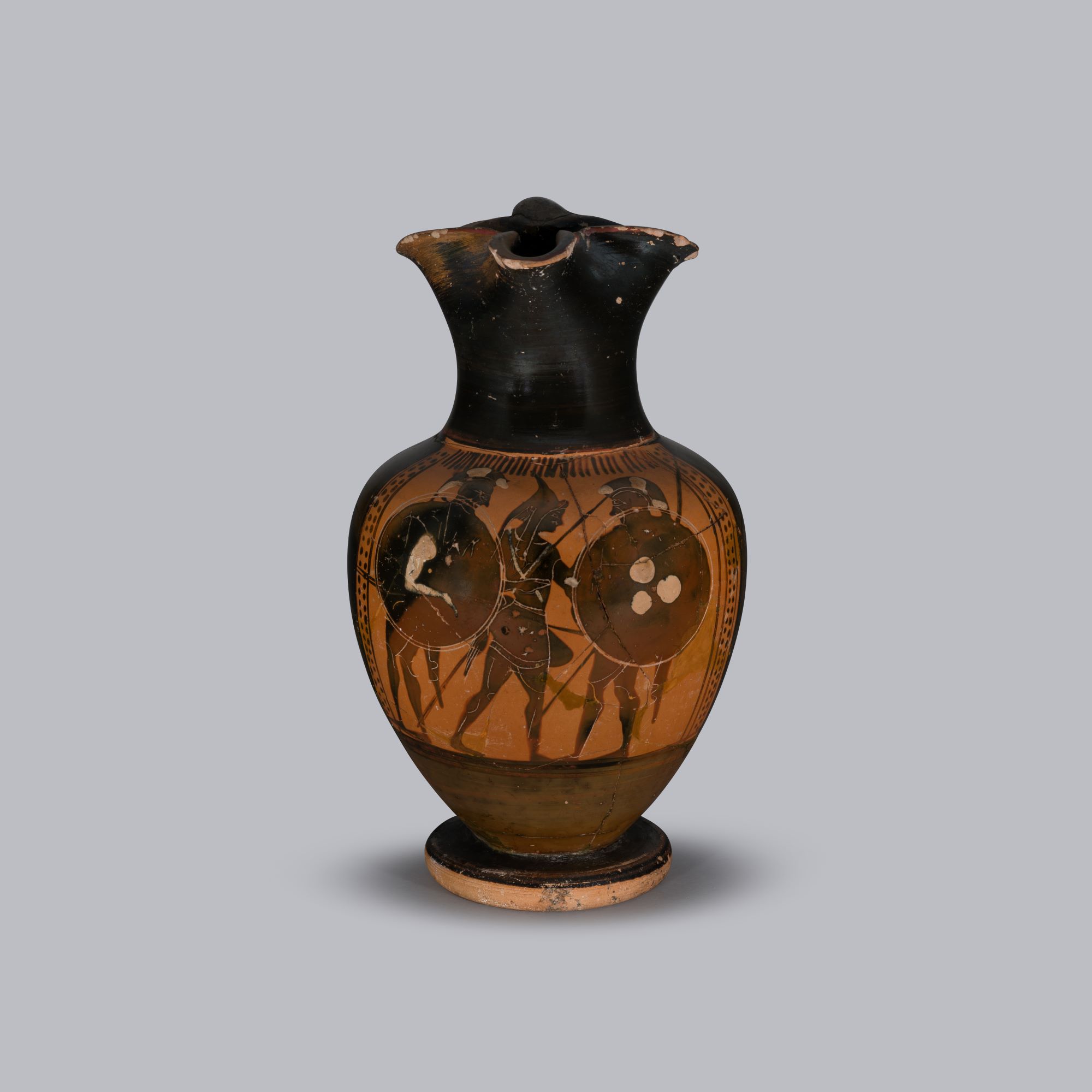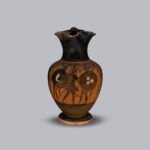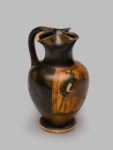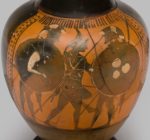
Oinochoe [Gr15]
Athenian Black-Figure, 500-490 BC
Painted terracotta (h. 22.5 cm, d (of body). 13.5 cm), mended with small restorations
Painted black leaving a panel under the spout with two hoplites and an archer, within a border of dots and dashes.
This oinochoe (literally wine-pourer) would have been used at the symposium. The painted decoration shows three soldiers: two hoplites with an archer between them. Hoplites were the citizen-soldiers of the Greek city-states. Their distinctive tactics and equipment began to develop around 700 BC and were well established by the 6th century BC. Hoplite soldiers fought with a long spear and a short sword, both of which are depicted here. Also visible on this vase are the characteristic bronze helmet, and bronze greaves to protect the shins. The hoplite carried a large circular shield about 80 cm in diameter, made of wood or leather and covered with bronze. These shields often had designs painted on them – here three discs on one shield, and a bent leg on the other. The hoplite was required to purchase all of this expensive equipment themselves.
The figure in the centre is identifiable as an archer from the quiver of arrows slung over his back. Like the hoplites, he carries a spear, but he has no shield or body armour. He wears a pointed headdress known as a Scythian cap. ‘Scythian’ was the Greek name for the nomadic peoples of the Black Sea coast, with whom they had quite close trading and diplomatic links. Archers in Scythian dress first appear on Athenian vases alongside hoplites in about 530 BC. This juxtaposition invited the viewer to contrast the Greek soldier with an oriental ‘other’ – a difference underlined by the fact that the Athenian army in the late 6th century did not include archers.
The figure of the Scythian archer disappears from Greek vases soon after 500 BC, and this wine jug, which dates from around 490 BC, must be among the last to include one. It was painted at a time of great change in the military affairs of Athens. The democratic reforms of Kleisthenes in 508 included a radical reorganisation of the army. Over the next few decades, the military fortunes of the city were transformed with major victories over the Boeotians and Chalcidians in 506, and against the Persians in 490 and 480. In the 480s, the Athenian army established a corps of archers. This must have removed the connotations of ‘otherness’ exemplified by the Scythian archer, and helps explain their disappearance from vases.
Some of the paint on this vase has misfired, turning brown rather than the intended black colour. Greek vases were decorated before firing with dark brown slip (liquid clay). In the first stage of firing the whole vase, both the painted and unpainted areas, turned red. In the second stage, the oxygen supply to the kiln was cut and the whole vase turned black. Finally, oxygen was reintroduced, turning the unpainted clay red once again, but not the areas painted with slip, which had been ‘sealed’ during the second phase of firing and so remained black. In this case, the painted slip was not fully sealed in the second stage of firing (either because too much oxygen remained in the kiln, or a high enough temperature was not reached), and so it partially reoxidised and changed from black back to brown in the third stage. The fact that this vase has survived intact suggests that it was considered acceptable despite this defect.
Literature: J. Falconer and T. Mannack, Corpus Vasorum Antiquorum: Great Britain, Fascicule 19: Winchester College (Oxford, 2002), p. 5, plate 4.8-10; Winchester College Memorial Buildings: Department of Classical Art (Winchester, 1909), p. 17 (no. 43)
Provenance: From Orvieto, at Winchester College by 1909
Location: Treasury, Gallery 3


